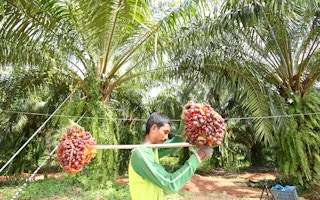In a bid to push the palm oil sector towards greater transparency, a group of 19 non-profit organisations has released new reporting guidelines that set out best practices for communicating environmental, social and labour issues in the crop’s supply chain.
To continue reading, subscribe to Eco‑Business.
There's something for everyone. We offer a range of subscription plans.
- Access our stories and receive our Insights Weekly newsletter with the free EB Member plan.
- Unlock unlimited access to our content and archive with EB Circle.
- Publish your content with EB Premium.
Launched on Tuesday, the 16-page Reporting Guidance for Responsible Palm was jointly developed by green groups, sustainable investment advocates, and human rights organisations, with input from the private sector.
The guidelines lay out 21 indicators that palm oil growers, processors, and traders (GPT) should include in their corporate reporting.
The indicators cover eight categories: scope, supply chain transparency, monitoring and engagement, land acquisition and development, human rights, smallholders, compliance, and external initiatives. Specific data requirements include disclosing all of a company’s concession maps, names of their suppliers, and detailed descriptions of how they are addressing social, human rights, labour, and land conflict issues.
It also advises manufacturers and retailers on how to report on relevant indicators. For manufacturers, reporting requirements include the percentage of their palm oil that is traceable to mill or plantation level, how they support smallholders, and how much of their supply is certified sustainable.
Retailers, meanwhile, are expected to disclose the names of all the traders in their supply chains, their methodology for assessing and engaging suppliers, and their efforts to verify their palm oil policies through external parties.
The organisations behind the document included NGOs Mighty and Rainforest Alliance; sustainable investing advocates Ceres—which coordinated the effort—and Seventh Generation Interfaith Coalition for Responsible Investment; and reporting organisation CDP, formerly known as the Carbon Disclosure Project. Quite a long par to detail the participating groups.
David Bennell, programme director, Food and Capital Markets Initiative, Ceres, said in a statement that “numerous companies are putting resources towards sustainable palm oil; yet deforestation, land conflicts and labour issues persist.”
“Transparency on supply chain practices is critical for all stakeholders, investors, civil society groups, and businesses, to understand and address the implementation gap,” he added.
The groups behind the document added that it served two key purposes: First, to set standards for how companies in the palm oil supply chain can communicate their responsible sourcing and production activities to the public in a transparent manner.
Second, the guidelines could inform dialogue and due diligence processes between companies, suppliers, civil society groups, and investors.
“
Transparency on supply chain practices is critical for all stakeholders, investors, civil society groups, and businesses, to understand and address the implementation gap.
David Bennell, program director, Food and Capital Markets Initiative, Ceres.
Companies should report the information outlined in the guidelines through existing channels, such as corporate sustainability reports and dashboards, noted the authors, adding that the guidelines built on existing recommendations that had already been made by various sustainability efforts within the industry; for example, the Zoological Society of London’s Sustainable Palm Oil Transparency Toolkit (SPOTT), which ranks palm oil companies on how much sustainability information they make publicly available.
The palm oil industry, which according to some market researchers was worth US$65.7 billion in 2015, is expected to produce about 64.5 million metric tonnes of the ubiquitous commodity from 2016 to 2017. The world’s most abundant vegetable oil, palm oil is found in everything from snacks and instant foods to cosmetics, toiletries, and biofuels.
However, the industry has been mired in various environmental and social problems including widespread deforestation in Indonesia, human rights abuses of plantation workers, and land-grabbing from communities without their consent, despite a multitude of pledges by companies to undertake “no deforestation, no exploitation, no peat development” policies across their operations.
Aditi Sen, senior policy advisor, Oxfam—one of the groups behind the guidelines—said that her organisation is concerned about the palm oil industry’s environmental and human rights record.
“We hope this guidance spurs greater transparency in the sector, ultimately contributing to sector transformation,” she said.
Investors added that the data included in these guidelines would help them make better financing decisions.
Kate Kroll, shareholder advocate at investment firm Green Century Capital Management, for example, noted that issues such as rainforest destruction or child labour create regulatory risks for companies, and could even undermine their social license to operate.
“Companies need to be transparent about how they are managing these risks so that we, as investors, can identify and measure them effectively,” she said.
Retailers also welcomed the guidelines.
Fiona Wheatley, sustainable business manager at British retailer Marks and Spencer (M&S), said that the company recognises the value of transparency in supply chain management, and is working with its industry partners to measure and compare the sustainability performance of its palm oil suppliers.
“This document guides companies towards reporting that is most meaningful and material to a wide range of stakeholders and contributes towards our collective goal of making palm oil production sustainable and deforestation free,” said Wheatley.










